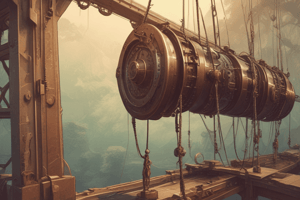Podcast
Questions and Answers
What is the primary role of the patella in relation to the quadriceps muscle?
What is the primary role of the patella in relation to the quadriceps muscle?
- To stabilize the tibial tuberosity during movement
- To decrease the angle of insertion of the patellar tendon
- To act as a buffer between the muscle and tendon
- To increase the efficiency of the quadriceps muscle (correct)
Which anatomical structure acts as a pulley for the peroneus longus muscle?
Which anatomical structure acts as a pulley for the peroneus longus muscle?
- The tibial tuberosity
- The lateral epicondyle of the femur
- The lateral malleolus of the fibula (correct)
- The first metatarsal bone
What type of anatomical pulley is represented by the trochlea of the eye?
What type of anatomical pulley is represented by the trochlea of the eye?
- A bone pulley
- A ligamentous pulley
- A fibrous band pulley
- A cartilage pulley (correct)
How do retinacular structures in the hand enhance finger flexion?
How do retinacular structures in the hand enhance finger flexion?
Which class of anatomical pulleys includes the lateral malleolus acting on the peroneus longus muscle?
Which class of anatomical pulleys includes the lateral malleolus acting on the peroneus longus muscle?
What effect would the absence of a pulley have on the superior oblique muscle of the eye?
What effect would the absence of a pulley have on the superior oblique muscle of the eye?
What is the primary function of articulation in Class III pulleys?
What is the primary function of articulation in Class III pulleys?
How do anatomical pulleys improve muscle mechanics?
How do anatomical pulleys improve muscle mechanics?
What is the primary function of a fixed pulley?
What is the primary function of a fixed pulley?
Which of the following best describes a movable pulley?
Which of the following best describes a movable pulley?
In the context of anatomical pulleys, what is typically replaced by a bone or cartilage?
In the context of anatomical pulleys, what is typically replaced by a bone or cartilage?
What role do anatomical pulleys play in muscle action?
What role do anatomical pulleys play in muscle action?
What classification of anatomical pulleys involves a movable pulley?
What classification of anatomical pulleys involves a movable pulley?
How does the arrangement of the upper pulley in a movable pulley system influence its function?
How does the arrangement of the upper pulley in a movable pulley system influence its function?
Which of these statements is true concerning the mechanical advantage in pulleys?
Which of these statements is true concerning the mechanical advantage in pulleys?
What happens to the force applied when using a movable pulley?
What happens to the force applied when using a movable pulley?
Flashcards are hidden until you start studying
Study Notes
Pulleys Overview
- A pulley is a grooved wheel that rotates around a fixed axis, typically driven by a rope.
- Pulleys can function as fixed or movable systems, aiding in the direction and magnitude of applied force.
Fixed Pulleys
- Designed to change the direction of a force without altering its magnitude.
- Typically used to apply traction or weights at various angles.
- Consists of a fixed pulley block and a rope with one end attached to a weight and the other to the applied effort.
Movable Pulleys
- Provide mechanical advantage, allowing heavier weights to be lifted more easily.
- Feature an upper pulley fixed to an overhead support, with the rope wrapped around the movable pulley where the weight is attached.
- The effort is applied at the free end of the rope.
Anatomical Pulleys
- In anatomy, bones, cartilage, or ligaments replace mechanical pulleys, with muscles represented by tendons.
- Tendons are lubricated to allow smooth movement over these anatomical pulleys.
- Anatomical pulleys enhance muscle function by aiding in the movement and placement of tendons over external supports.
Classification of Anatomical Pulleys
-
Class I:
- Involves tendons passing over external supports (e.g., patella acts as a pulley for quadriceps, improving insertion angle).
-
Class II:
- Alters muscle action at the joint through:
- Bone: Lateral malleolus serves as a pulley for the peroneus longus muscle, enabling proper ankle movement.
- Cartilage: Trochlea of the eye allows the superior oblique muscle to rotate the eye, enhancing functionality.
- Ligament: Retinacular structures stabilize flexor tendons in the hand, promoting efficient finger flexion through the carpal ligament and digital flexor pulley systems.
- Alters muscle action at the joint through:
-
Class III:
- The joint itself serves as the pulley, facilitating movement.
Functional Importance of Pulleys
- Pulleys, both mechanical and anatomical, play a crucial role in exerting and altering forces, aiding in various physical activities and movements.
Studying That Suits You
Use AI to generate personalized quizzes and flashcards to suit your learning preferences.




